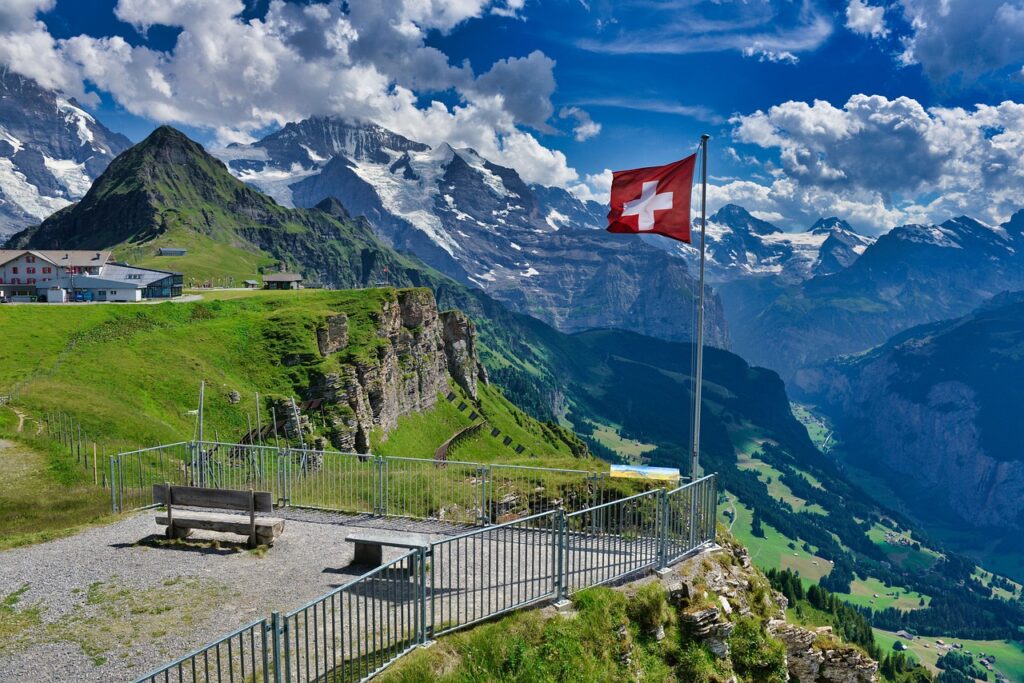
Hiking Trails in the Swiss Alps for Panoramic Views
The Swiss Alps, renowned for their majestic beauty, offer hikers an unparalleled experience. Towering peaks, pristine lakes, and sweeping vistas await those who embark on these trails. Imagine yourself surrounded by snow-capped peaks, crystal-clear skies, and a sense of serenity that only nature can provide. In this guide, we’re diving into the breathtaking world of hiking trails in the Swiss Alps for panoramic views. If you’re seeking an unforgettable trek amidst stunning natural landscapes, you’re in the right place.
Why Hike in the Swiss Alps?
The Swiss Alps beckon with their irresistible allure, attracting outdoor enthusiasts from around the globe. What makes hiking in the Swiss Alps so enticing? Let’s delve into the reasons:
The Swiss Alps are a treasure trove of natural beauty. Towering peaks, lush valleys, and pristine lakes paint a picture of awe-inspiring landscapes. Hiking here means immersing yourself in a world where every step offers a new, jaw-dropping view.
Panoramic views in the Swiss Alps are the stuff of dreams. Imagine standing on a mountaintop, surrounded by 360-degree vistas of snow-capped peaks, verdant meadows, and clear blue skies. These views are unparalleled and a photographer’s paradise.
Hiking isn’t just a physical endeavor; it’s a boon for mental health. The Swiss Alps provide an idyllic setting to disconnect from the daily grind, clear your mind, and rejuvenate your spirit. The crisp mountain air and tranquil surroundings work wonders for your overall well-being.
Beyond the natural wonders, the Swiss Alps offer a rich cultural tapestry. Encounter charming Alpine villages, traditional Swiss customs, and warm hospitality along the way. It’s a chance to immerse yourself in local culture and create lasting memories.
The Swiss Alps provide an opportunity to reconnect with nature in its purest form. The soothing sounds of flowing streams, the scent of alpine flora, and encounters with local wildlife create a bond with the environment that’s truly special.
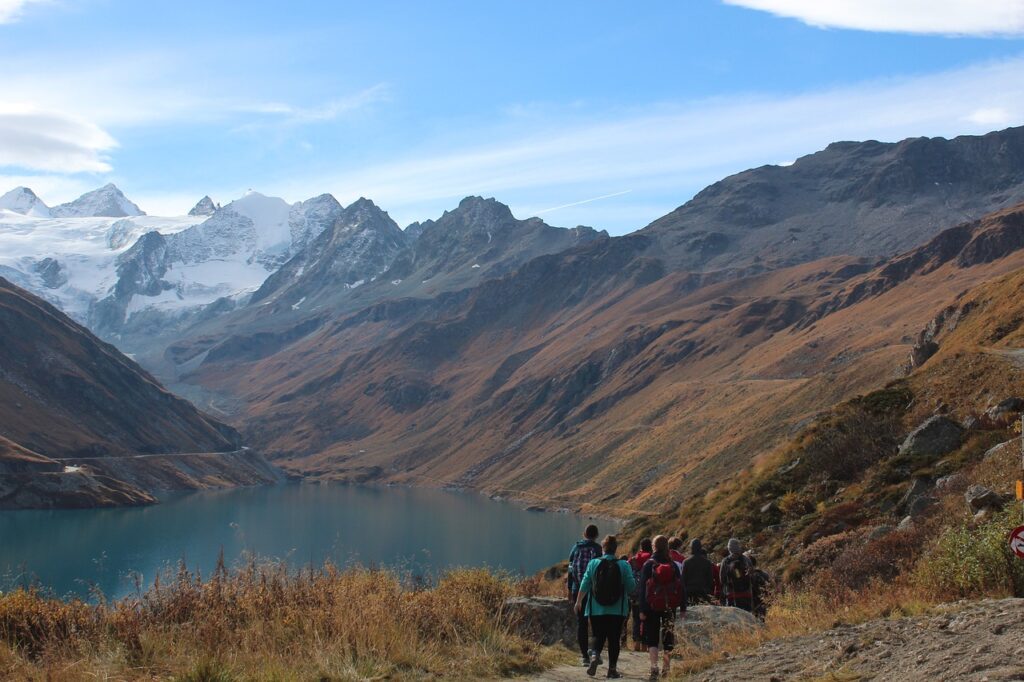
Essential Hiking Gear
To make the most of your hiking adventure in the Swiss Alps and ensure your safety and comfort, it’s crucial to have the right gear. Here’s a checklist of essential hiking gear to consider:
Hiking Boots: Invest in a sturdy pair of hiking boots with good ankle support. They should be comfortable for long walks and provide excellent traction on rocky terrain.
Clothing: Dress in layers to adapt to changing weather conditions. Opt for moisture-wicking base layers, insulating mid-layers, and waterproof outer layers. Don’t forget a wide-brimmed hat and sunglasses to protect against the sun.
Backpack: Choose a comfortable and well-fitted backpack to carry your gear. It should have enough capacity for essentials like water, food, extra clothing, and first aid supplies.
Navigation Tools: Carry a map, compass, or GPS device to navigate the trails confidently. Familiarize yourself with the trail routes before setting out.
Water and Hydration: Stay hydrated by carrying a refillable water bottle or a hydration reservoir. In the Swiss Alps, you can often refill your bottle with fresh mountain water, but purification tablets are a good backup.
Food and Snacks: Pack lightweight, energy-rich snacks like trail mix, energy bars, and dried fruits. For longer hikes, consider a packed lunch with sandwiches or wraps.
First Aid Kit: Prepare a basic first aid kit with bandages, antiseptic wipes, pain relievers, and any personal medications you may need.
Sun Protection: Protect your skin from the Alpine sun with sunscreen, lip balm with SPF, and sunglasses. The high-altitude sun can be intense.
Insect Repellent: Depending on the season and location, insects can be a nuisance. Carry insect repellent to ward off unwanted bites.
Headlamp or Flashlight: Be prepared for low light conditions or unexpected delays by carrying a reliable headlamp or flashlight with extra batteries.
Trekking Poles: Consider using trekking poles for added stability and to reduce the impact on your knees during descents.
Personal ID and Emergency Information: Carry identification, emergency contact details, and any relevant permits in a waterproof pouch.
Cash and Local Currency: Some mountain huts and villages may not accept cards, so it’s wise to have cash on hand.
Waste Disposal Bags: Practice Leave No Trace principles by carrying waste disposal bags for used tissues and trash.
Best Time to Hike
Choosing the right time to plan your hiking adventure in the Swiss Alps can significantly impact your experience. Here’s a breakdown of the different seasons and their advantages:
Summer (June to August)
Advantages:
- Mild temperatures make for comfortable hiking conditions.
- Alpine wildflowers are in full bloom, painting the landscapes with vibrant colors.
- Longer daylight hours provide ample time for exploration.
- Most trails and mountain huts are open, offering a wide range of options.
Considerations:
- Popular trails can get crowded, especially in July and August.
- Be prepared for occasional afternoon thunderstorms, especially at higher elevations.
Fall (September to October)
Advantages:
- Crisp, cool weather is perfect for hiking.
- Crowds thin out compared to the summer months.
- The changing foliage creates a stunning tapestry of reds and yellows.
Considerations:
- Some mountain huts and services may start closing in late September.
- Weather can become more unpredictable as the season progresses.
Winter (November to April)
Advantages:
- Winter hiking offers a serene, snow-covered landscape.
- Opportunities for snowshoeing and cross-country skiing abound.
- Peace and solitude prevail with fewer hikers on the trails.
Considerations:
- Specialized winter gear, including snowshoes and crampons, may be required.
- Avalanches and icy conditions can pose additional risks, so check trail conditions and avalanche forecasts.
Spring (May)
Advantages:
- As the snow begins to melt, the landscape comes to life.
- It’s a quiet and peaceful time to explore the mountains before the summer rush.
Considerations:
- Some higher-altitude trails may still be snow-covered and inaccessible.
- Weather can be unpredictable, so be prepared for varying conditions.
General Tips:
- Check trail conditions and weather forecasts before setting out.
- Make reservations for accommodations and mountain huts in advance, especially during the peak summer season.
- Be aware of any seasonal trail closures or restrictions, which can vary by region and elevation.
The best time to hike in the Swiss Alps ultimately depends on your preferences, the type of experience you seek, and your comfort with varying weather conditions. Whether you prefer the vibrant blooms of summer or the tranquility of a winter wonderland, the Swiss Alps offer panoramic views and hiking adventures year-round.
Top Hiking Trails for Panoramic Views
Now, let’s dive into the heart of your Swiss Alps adventure—the hiking trails that promise those unforgettable panoramic views. Here are some of the top trails to explore:
Eiger Trail
- Difficulty: Moderate
- Distance: Approximately 6 kilometers
- Estimated Duration: 2-3 hours
- Highlights: This trail offers up-close views of the iconic Eiger North Face. You’ll pass through alpine meadows and enjoy vistas of the Grindelwald Valley.
Schynige Platte Panorama Trail
- Difficulty: Easy to Moderate
- Distance: Around 5.5 kilometers
- Estimated Duration: 2-3 hours
- Highlights: Enjoy sweeping panoramic views of the Jungfrau, Eiger, and Mönch mountains. This trail is known for its stunning wildflower displays in summer.
First Cliff Walk
- Difficulty: Easy
- Distance: Short loop
- Estimated Duration: 1-2 hours
- Highlights: Experience an adrenaline rush as you walk along a secure cliff-side pathway with glass panels. The views of the Grindelwald Valley and surrounding peaks are breathtaking.
Five Lakes Walk (Pizol)
- Difficulty: Moderate
- Distance: Approximately 9 kilometers
- Estimated Duration: 3-4 hours
- Highlights: This trail takes you past five crystal-clear mountain lakes, each reflecting the stunning peaks of the Swiss Alps. The scenery is simply magical.
Gornergrat Ridge Trail
- Difficulty: Easy to Moderate
- Distance: Around 5 kilometers
- Estimated Duration: 2-3 hours
- Highlights: Hike along the Gornergrat ridge for magnificent views of the Matterhorn, Monte Rosa, and surrounding peaks. This trail is accessible by taking the Gornergrat Railway.
The Haute Route
- Difficulty: Challenging
- Distance: Approximately 180 kilometers (varies by section)
- Estimated Duration: 12-15 days (for the entire route)
- Highlights: For the seasoned hiker, the Haute Route traverses some of the most spectacular alpine terrain in Switzerland, with panoramic views at every turn.
Harder Kulm Panorama Trail
- Difficulty: Easy to Moderate
- Distance: Short loop
- Estimated Duration: 1-2 hours
- Highlights: Begin your hike from Interlaken and ascend to Harder Kulm for stunning views of the Jungfrau region and the turquoise waters of Lake Thun and Lake Brienz.
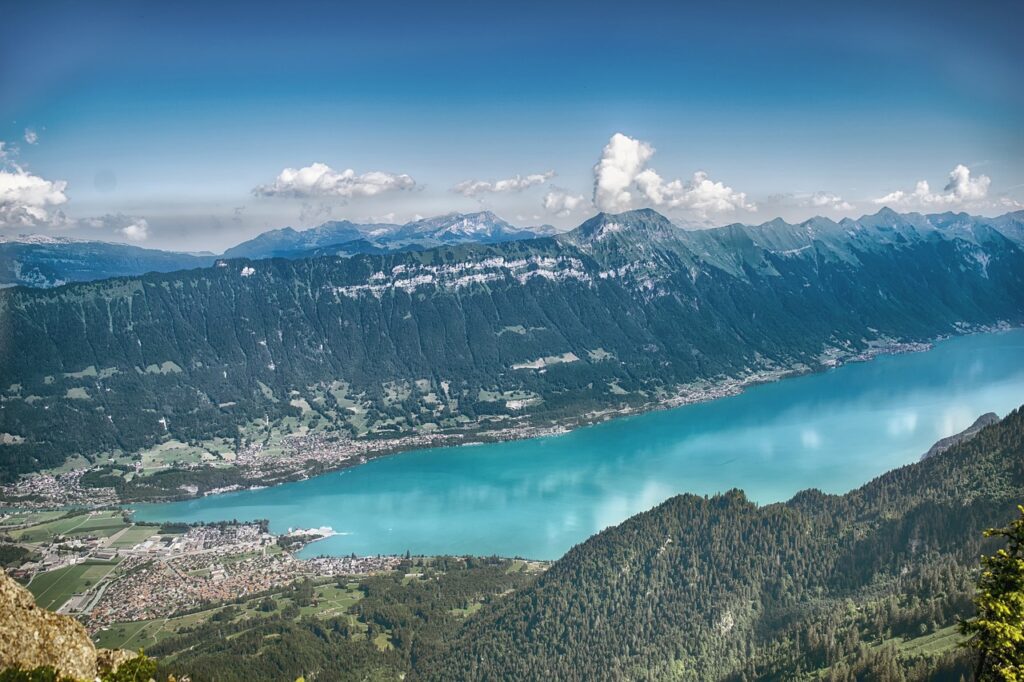
Hiking Tips and Safety
When planning to go on hiking trails in the Swiss Alps, it’s essential to be well-prepared and informed. Here are some valuable hiking tips and safety guidelines:
Plan Ahead:
- Research your chosen trail thoroughly, including its difficulty level, distance, and elevation gain.
- Check the weather forecast and trail conditions before setting out. Be prepared for changing weather in the mountains.
Inform Others:
- Share your hiking itinerary with a trusted friend or family member. Let them know your estimated start and return times.
- Consider carrying a personal locator beacon or satellite communicator for emergencies.
Hiking Essentials:
- Always carry essential hiking gear, including a map, compass, or GPS device.
- Dress in moisture-wicking layers to stay comfortable and dry throughout the hike.
Stay Hydrated:
- Carry an adequate supply of water. In the Swiss Alps, you can often refill your bottle from mountain streams, but use purification tablets for safety.
Pace Yourself:
- Take breaks as needed and pace yourself according to your fitness level. Altitude can affect your endurance, so acclimate gradually if necessary.
Wildlife Awareness:
- Respect the local wildlife by observing from a distance. Do not feed or approach animals.
- Familiarize yourself with the potential presence of wildlife like ibex and chamois in the area.
Leave No Trace:
- Follow the Leave No Trace principles by carrying out all trash and waste. Dispose of waste properly at designated locations.
Trail Etiquette:
- Yield the trail to uphill hikers and follow any posted signs or regulations.
- Keep noise levels to a minimum to avoid disturbing the natural environment and other hikers.
Emergency Protocol:
- Familiarize yourself with emergency procedures and contact information for local authorities and rescue services.
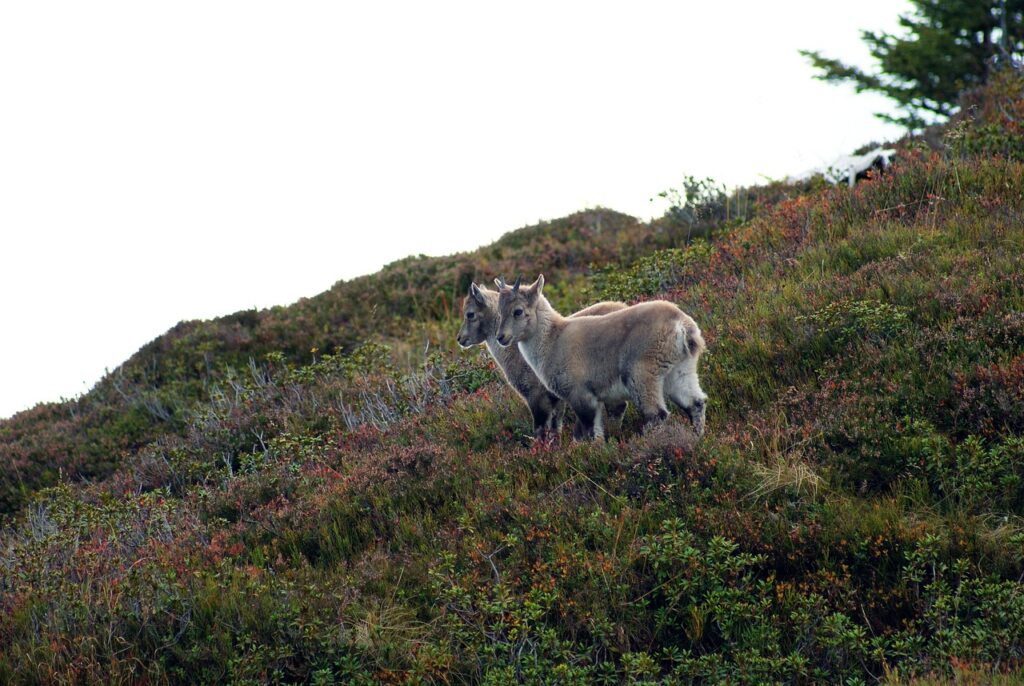
Accommodations and Logistics
Hiking in the Swiss Alps involves careful planning when it comes to accommodations and logistics. Here’s what you need to know:
Accommodations:
- Mountain Huts: Many hiking trails in the Swiss Alps offer mountain huts where you can stay overnight. These provide a rustic yet charming accommodation option in the heart of the mountains. Be sure to make reservations in advance, especially during peak hiking seasons.
- Hotels and Lodges: In larger towns and villages, you’ll find a range of hotels, lodges, and guesthouses. These offer comfortable amenities and are perfect for relaxing before or after your hike.
Transportation:
- Getting to the Alps: Depending on your starting point, you can reach the Swiss Alps by train, car, or even by flying into cities like Zurich, Geneva, or Bern. Swiss public transportation is highly efficient and can take you to most hiking destinations.
- Local Transportation: Once in the Alps, you can rely on an extensive network of trains, buses, cable cars, and funiculars to access trailheads and explore the region. Consider purchasing a Swiss Travel Pass for unlimited travel on the Swiss Travel System.
Permits and Fees:
- Trail Permits: Some trails and national parks may require permits. Check in advance and obtain any necessary permits for your chosen hikes.
- Hiking Passes: Consider purchasing a hiking pass if you plan to use cable cars or mountain railways frequently. These passes often provide discounts and unlimited rides.
Dining and Cuisine:
- Mountain Cuisine: Don’t miss the opportunity to savor local Alpine cuisine at mountain huts. Try Swiss specialties like fondue, raclette, and rösti. These hearty dishes are perfect for refueling after a day on the trails.
- Village Dining: In towns and villages, explore the diverse culinary scene. Swiss cuisine combines elements of German, French, and Italian traditions, so you’ll find a wide range of delicious options.
Language and Culture:
- Languages: Switzerland has four official languages—German, French, Italian, and Romansh. Depending on the region you’re in, you’ll encounter different languages and cultures. Learning a few basic phrases in the local language can enhance your experience.
- Cultural Etiquette: Familiarize yourself with Swiss customs and etiquette, such as greeting with a handshake, punctuality, and respecting personal space.
Travel Insurance:
- Health Coverage: Ensure you have adequate travel insurance that covers health emergencies, including mountain rescue if needed.
- Cancellation Insurance: Consider trip cancellation insurance to protect your investment in case unforeseen circumstances force you to change your plans.
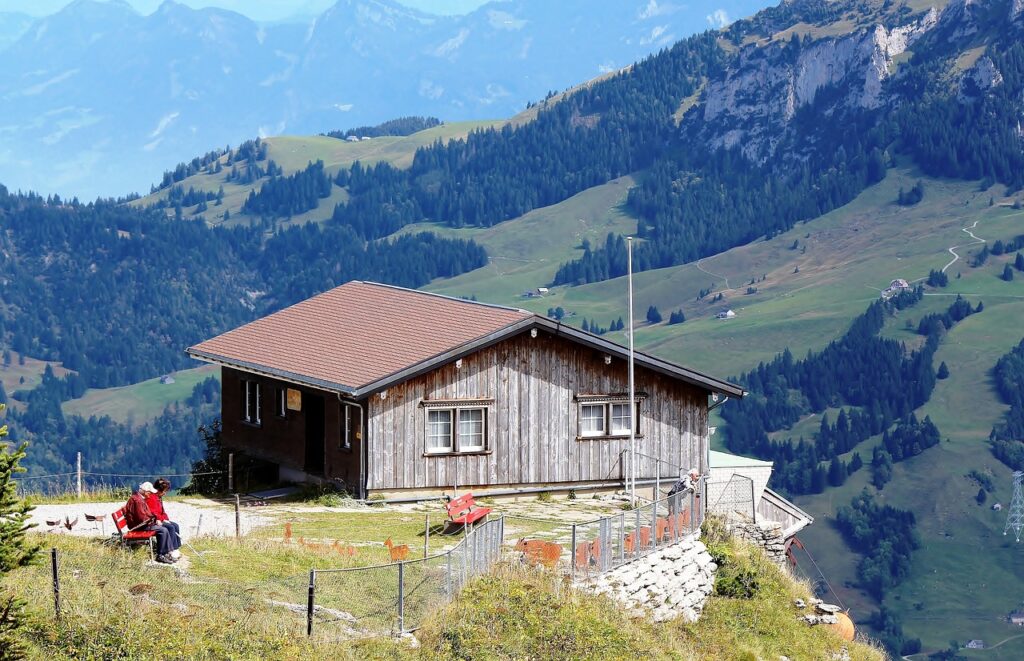
Local Cuisine and Culture
Immersing yourself in the local culture and cuisine of the Swiss Alps is an integral part of your hiking adventure. Here’s a glimpse into the culinary delights and cultural experiences that await you:
Swiss Alpine Cuisine:
- Fondue: Indulge in the iconic Swiss fondue, a communal pot of melted cheese served with bread cubes for dipping. It’s a must-try Alpine experience.
- Raclette: Savor raclette, where a wheel of cheese is heated, scraped, and served over potatoes, pickles, and onions. It’s a comforting and hearty dish.
- Rösti: Taste rösti, a Swiss-style potato pancake that’s crispy on the outside and tender on the inside. It often accompanies main dishes.
Mountain Hut Dining:
- Enjoy traditional Alpine meals at mountain huts along your hiking trails. These huts offer a cozy ambiance, delicious food, and stunning views. Reserve in advance for dinner or an overnight stay.
Swiss Chocolate:
- Switzerland is renowned for its chocolate. Don’t leave without sampling some Swiss chocolate bars or pralines. They make for delightful trail snacks or souvenirs.
Local Festivals and Events:
- Check if there are any local festivals or events happening during your visit. These can provide unique cultural insights and entertainment.
Engage with Locals:
- Strike up conversations with locals you meet along the way. Swiss people are known for their friendliness and are often eager to share stories and insights about their region.
Swiss Traditions:
- Embrace Swiss traditions, such as yodeling, alphorn music, and flag throwing, which are often showcased at cultural events.
Visit Alpine Villages:
- Take time to explore charming Alpine villages and towns. Wander through the cobblestone streets, admire traditional chalet architecture, and shop for local handicrafts.
Cultural Museums:
- If you’re interested in delving deeper into Swiss culture, consider visiting local museums and exhibitions that showcase the history and traditions of the region.
Language and Greetings:
- Learn a few basic phrases in the local language, depending on the region you’re in. A simple “hello” and “thank you” in German, French, or Italian can go a long way.
Souvenirs:
- Bring home souvenirs such as Swiss watches, cowbells, traditional clothing, or locally crafted items to commemorate your Alpine adventure.
As we conclude this guide to hiking trails in the Swiss Alps for panoramic views, we hope you’re inspired to embark on your own adventure in this breathtaking region. The Swiss Alps offer more than just stunning landscapes; they provide an opportunity to reconnect with nature, experience rich culture, and savor delicious cuisine.
Remember the key takeaways from this guide:
- Plan your hiking adventure carefully, considering the best time to visit, essential gear, and safety precautions.
- Choose from a variety of trails, each offering its unique charm and panoramic views.
- Embrace Swiss culture by savoring local cuisine, engaging with locals, and learning about traditions.
- Take the time to explore charming Alpine villages and immerse yourself in the beauty and hospitality of the region.
Your journey in the Swiss Alps promises to be a tapestry of unforgettable moments, from sunrise hikes to evenings spent enjoying Swiss fondue in a mountain hut. So, pack your backpack, capture those panoramic views, and let the Swiss Alps leave an indelible mark on your heart.

Hey Andrew,
Your article really nails it when it comes to showing how the Swiss Alps are a total paradise for nature lovers, adventurers, and anyone who wants to soak up some of that natural wonder.
I gotta say, your article does a great job of covering all the bases, from must-have hiking gear to safety tips and even the local culture and food scene. It’s like a one-stop shop for anyone thinking about trekking through the Swiss Alps, whether they’re a newbie or a seasoned pro.
And kudos for highlighting responsible hiking and the importance of preserving the beauty of the Alps. We all want these stunning landscapes to stay just as amazing for the generations to come.
Keep up the awesome work!
Hi Hari,
I am glad you came across my article and enjoyed it! The Swiss Alps are definitely a paradise for nature lovers!
Thank you for the kind words!
-Andrew
Hiking the alps has been a bucket list item of mine for over 5 years- I’ve been to many other places but been a bit intimidated by the variety of hikes and how difficult each one could be. I really love how you’ve broken down several trails by difficulty level and length. Definitely bookmarking this page for future reference.
Hi Janani,
Thank you for the comment! I am glad you enjoyed the information. I do agree that hiking the Alps sounds intimidating, but luckily there are plenty of easier hikes and other options to see the beauty of the Alps without a strenuous hike!
Hope you get to check that one off your bucket list!
Andrew